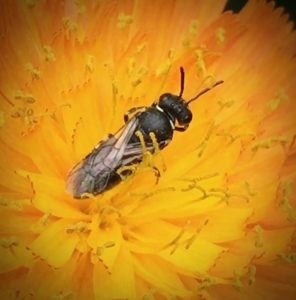Yellow Face bees (Hylaeus sp.) in my wildlife garden
I must admit these bees are tiny and therefore very easily overlooked. When I got my ‘eye-in’, I had to use Steven Falk’s excellent book and his website to try to find what they were, so I may be wrong! Reading this book made me look at them, especially the female foraging on the Orange hawkweed, (a great forage plant for other solitary bees) in more detail. I noticed she had no scopa or pollen brushes on her body. They could easily be mistaken for a solitary wasp.
Falk states that these bees, unusually for solitary bees, lack pollen collecting hairs. The majority of them carry pollen in their crop and regurgitate it back at the nest. They nest inside various hollow plant stems and pre-existing holes in wood, walls and vertical earth banks. I have seen a male resting inside one of my smaller sized nesting blocks inside a Nurturing Nature nest box and in 2018 several females actually nested inside some of my summer units, video sometime in the future. They line their nest cells with a waterproof cellophane-like substance, using the tongue to apply it. I watched as they foraged on Orange hawkweed and Hedgerow cranesbill.
See Yellow Face bees making their cellophane-like nest
“All my articles and videos, available free, are funded by my presentations and sales of award-winning bumblebee nest boxes, solitary bee boxes, and wormeries. Please help by spreading the word and forwarding this link to your friends and colleagues. https://nurturing-nature.co.uk Thank you” George Pilkington
For info and link to buy an excellent book Field Guide to the Bees of Great Britain and Ireland by Steven Falk
An extremely useful resource supports this book by a special website feature within Steve Falk’s Flickr website which furnishes extra photos and other useful resources to assist with identification.
Solitary Bees book by Ted Benton
Interested in Citizen Science and pollinators? The Buzz Club


Recent Comments